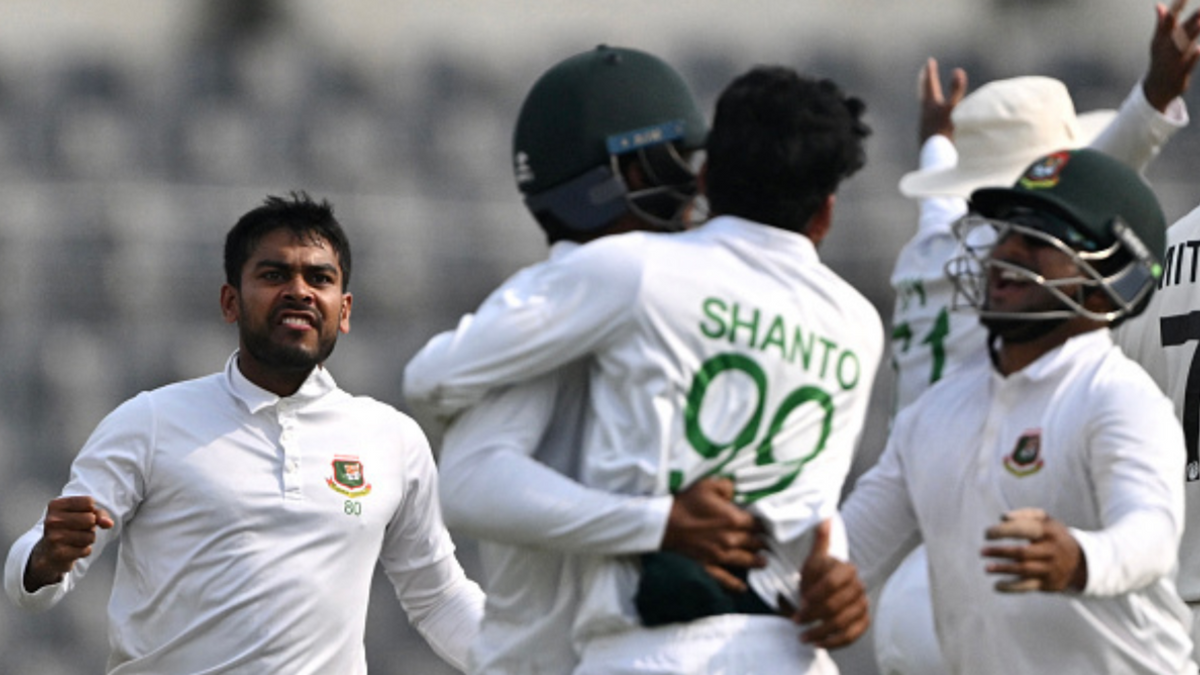
Bangladesh have won three of their four Tests in 2023 with a close defeat to New Zealand their only loss. While these are encouraging signs, their approach could be working against them, writes Sarah Waris.
Subscribe to the Wisden Cricket YouTube channel for post-match analysis, player interviews, and much more.
There were plenty of positives for Bangladesh in their two-Test series against New Zealand, which ended 1-1. Najmul Hossain Shanto, a desperate pick as captain in the absence of the first-choice players, led from the front, stepping up against an experienced bowling attack to become the first Bangladesh skipper to score a Test ton since 2021.
Overcoming the lows of the 2023 World Cup without several senior players would always be a challenge. Still, the young side, without their regular skipper or vice-captain, two main fast bowlers and experienced openers, throttled the touring side. They showed calmness when batting and put on a masterclass in spin bowling throughout the two Tests and if it wasn’t for Glenn Phillips’ all-round show at Mirpur, Bangladesh could have won their first Test series against New Zealand.
After finishing last in the previous edition of the World Test Championship, this time around Bangladesh decided to maximise their advantage at home on more result-oriented slow tracks with Shanto saying, “When we play Tests, we are not here to improve. This is not a place for practice. We are trying to win the Test. It is important that we prepare to win the Test and we should definitely take advantage of home conditions.” It highlighted how Bangladesh were keen to carry forward their ODI template of playing on slower wickets into the longer format to force favourable results at home.
The wicket used for the second Test in Dhaka was a square turner after a low track in Sylhet for the first game. In the second Test, 30 of the 35 wickets taken by bowlers went to the spinners. Runs were hard to come by, with the visitors struggling in their run chase of 137, being reduced to 69-6, before finally getting to the score.
New Zealand skipper Tim Southee termed the track at Dhaka as “probably the worst” that he had encountered in his career, but Mehidy Hasan Miraz defended the decision to stick to spinning wickets, saying, “Whenever we play abroad, those teams take home advantage. We try to take it in Test cricket. If we can get these points in the WTC, we will be in a better position in the points table.”
This year, spinners from Bangladesh have taken 49 wickets in four matches at home, at an average of 21 – the second-best figures in a single year since 2016. They have also picked up wickets at a strike rate of 46.1, making it only the fourth time in a calendar year that Bangladesh slower bowlers have taken fewer than 50 balls per wicket. Interestingly, the current head coach Chandika Hathurusinghe was in charge in 2016 as well.
The touring batters have averaged 20.29 in Bangladesh, the worst they ever have in a single year there. But, the batters have found value for their shots, hitting 21 sixes in four games, indicating counter-attacking is a good solution on these wickets.
The only instance when Bangladesh have swayed from their plan was against Afghanistan this year, when a fast track was prepared in Dhaka to counter their rivals’ weakness against short bowling. Afghanistan also have a strong spin attack, seen in how they outwitted England and then Pakistan in the ODI World Cup on slower wickets, and it was a risk Bangladesh were unwilling to take. They ended up winning by a mammoth 546 runs.
But are the results a real indicator of Bangladesh’s prowess as an emerging Test side or is their home advantage rendering them more powerful than they are?
As far as the bigger picture is concerned, such tracks could only inflate the sense of invincibility while hindering the positive impact of the wins. Bangladesh churned out low wickets in ODIs in the lead-up to the 2023 World Cup as well, as they aimed for a direct qualification in the ICC ODI Super League.
Bangladesh ended third on the points table, winning 15 of their 24 ODIs from 2020 with eight losses and a No Result. The results were bolstered by their showings at home: Bangladesh won eight of 12 ODIs in the Super League, which included series wins against West Indies, Sri Lanka and Afghanistan.
Outside of the Super League, Bangladesh also hosted India, Ireland and New Zealand, with the highlight being the series win against a full-strength Indian side last year. Since the start of 2021, the Bangladesh spinners picked up 85 scalps at an average of below 25 and a strike rate of 32.8. The pitches prepared also suited their strength perfectly: In 24 ODIs, a team made more than 300 only six times, with 250 being breached on 12 occasions. Switching from playing on slower tracks to flatter venues in the World Cup proved to be a test for the Bangladesh batters, with the team crossing 300 only once in the event. They eventually ended eighth on the points table.
It is not to say that Bangladesh have completely relied on the pitches for their successes. They recorded a historic Test win against New Zealand at Mount Maunganui last year and beat South Africa in an ODI series where the pacers shone. But by preparing one-dimensional wickets at home, they are curbing the exposure the pacers get.
Only one fast bowler played against the Black Caps in the first Test in Sylhet and while immediate results will come through this approach, it is not necessarily what Bangladesh need.








